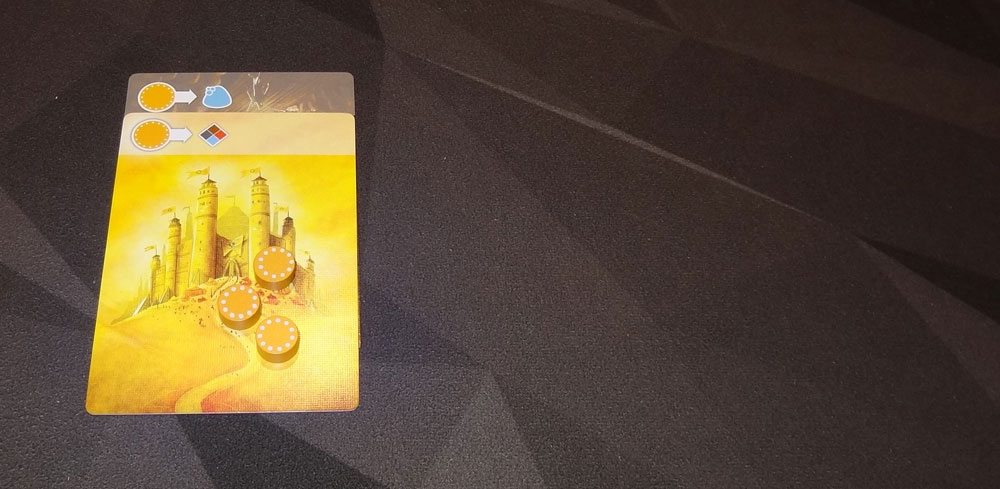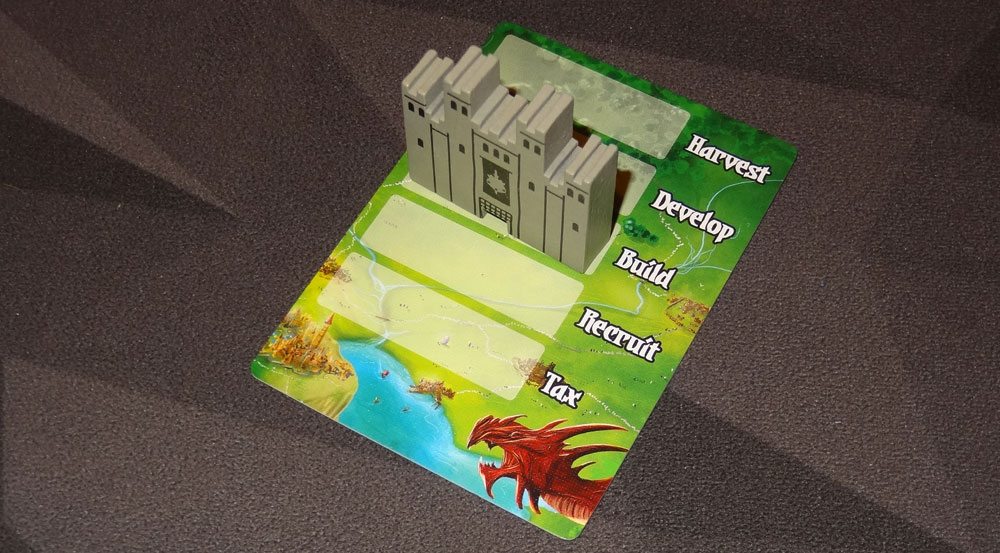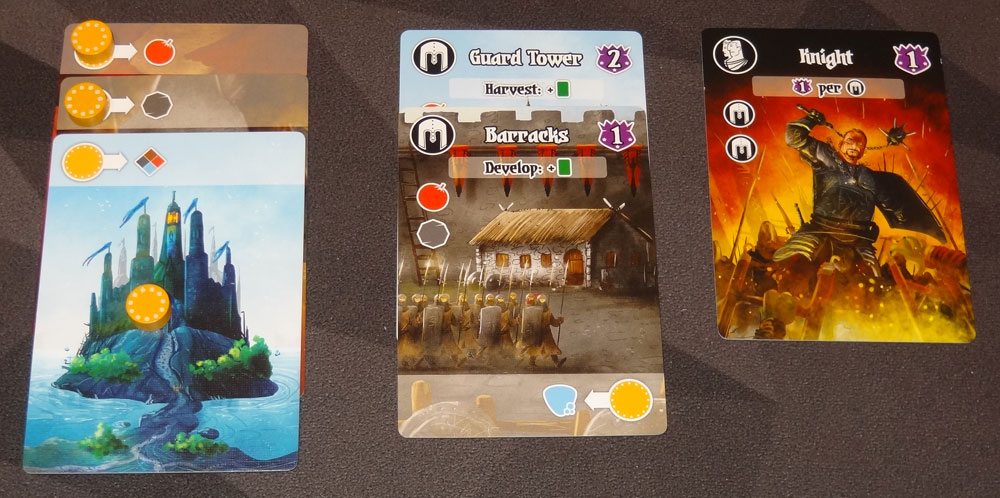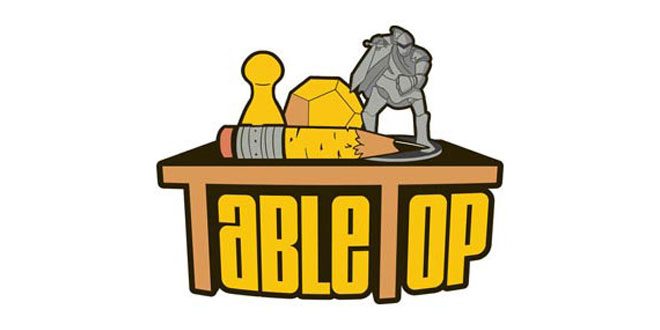“Reaping the Rewards” is a series of posts focusing on the finished products from crowdfunding campaigns. Today’s topic: Villages of Valeria, a card game that was successfully funded in February 2016, and is currently being shipped to backers. Its official release date is January 20, so even if you missed the Kickstarter campaign, you should be able to find it at your local game store or online then.
Note: This review is adapted from my original Kickstarter Tabletop Alert, updated with final components and rules.
In Villages of Valeria, you are a Duke, vying to become the capital city in the land of Valeria. Build up resources, construct buildings, and recruit adventurers. And pay no attention the hordes of monsters that are approaching… they arrive in the sequel.
At a glance: Villages of Valeria is a game by Daily Magic Games for 1 to 5 players, ages 14 and up, and takes about 30 minutes to play. It retails for $25, and the release date is January 20, 2017. Although the artwork for the adventurers can be a little intense, I don’t think there’s anything inappropriate for younger players, and I would say you could probably play this with kids as young as 10 or 12, depending on their level of experience.
Villages of Valeria is GeekDad Approved!

Components:
- 84 Building cards (3 each of 28 Buildings)
- 16 Adventurer cards
- 5 Castle cards
- 30 gold coins
- Active Player token
- Action Selection card
- 5 Player Aid cards
- Solo Play reference card
The final components list is similar to the list shown during the Kickstarter campaign, but with just a little more of everything, particularly because they reached stretch goals to add both a fifth player and a solo mode. There was also a Deluxe edition available through the Kickstarter that included a larger box for sleeved cards, a plastic insert rather than the cardboard divider, and the first expansion pack included.

The game is set in the same world as Valeria: Card Kingdoms, and the artwork is again from The Mico, so the artwork is in the same style. The Butcher and Blacksmith look familiar because they use the same artwork as V:CK, but the rest of the Adventurers are new artwork, many of them portraits of backers. I’m impressed by the number of unique illustrations used in the game—there are multiple copies of the Buildings, but even so there are 28 unique types, and all 16 Adventurers are unique. Even the 5 Castle cards are unique, even though it wasn’t necessary.
The Active Player token is a large wooden castle that is used to mark the chosen action on the Action Selection card, and the gold coins are small painted wooden disks that match the coin icon on the cards.
The box for the regular version is pretty compact, which is a bonus for me: it has a little bit of room for a few expansion packs, but not a whole lot of empty space. Overall, the component quality for the regular edition is quite nice.
How to Play
You can download a copy of the rules here, as well as a Print and Play version if you’d like to try it yourself. Finally, if you have Tabletop Simulator, you can try Villages of Valeria in digital form.
The goal of the game is to have the most Victory Points (in Buildings, Adventurers, and gold) by the end of the game.

To set up, give each player a Castle card, a Reference card, and 3 gold coins. The total bank of gold coins varies depending on the number of players. Shuffle the Building cards and deal 6 to each player. Turn 5 Building cards face-up on the table and set the deck nearby. Shuffle the Adventurer deck, turn 5 face-up and set the rest of the deck nearby. Give the active player marker to the first player.
Each player, in turn order, chooses a card from their hand to develop as a resource, tucking it upside-down under their Castle so the resource is visible at the top. There are various resources: Wood, Stone, Food, and Magic. Now the game is ready to begin.

During each turn, the active player will first recover any gold that is on their resource cards and the Castle. Then, the active player will choose an action, and then all the other players have an opportunity to follow that same action, though with a lesser benefit. Then the active player token passes to the next player, and the next turn begins.
Here are the available actions (and the follow actions):
- Harvest: Draw 3 cards. (Follow: Draw 1 card.)
- Develop: Discard 1 card, and then put a card under your Castle as a resource. (Follow: Discard 2 cards to develop a resource.)
- Build: Pay the cost of a Building to build it, and draw a card. (Follow: Pay the cost of a building to build it.)
- Recruit: Pay 1 gold to recruit an Adventurer. (Follow: Pay 2 gold to recruit.)
- Tax: Draw 1 card and take 1 gold from the supply. (Follow: No action.)

All of the “draw card” abilities refer to Building cards, not Adventurer cards. When you draw cards, you may draw the top card from any of the 5 face-up pools, or from the face-down deck. Face-up pools are replenished from the deck as soon as they are empty. When you discard cards, they are discarded into any of the pools of your choice. There’s a hand limit of 8 cards, though you only have to discard down after completing an action (whether leading or following). So you can temporarily have more than 8.
When you develop a card, you ignore everything on the card except the resource at the very bottom—the card is turned upside down and tucked under your Castle, with just that resource showing. The resources that you (and other players) have developed are now available for building, but you must spend gold on them to use them.
To pay for a Building, you must buy one of each resource shown on the Building card. You place gold coins on the resource cards to buy them; your Castle can provide a wild resource of your choice. You may only place gold on resources that don’t already have gold on them. However, you may use resources belonging to other players (but not their wild Castle resource)–but then the gold belongs to them.

When you recruit Adventurers, you must have the building types shown on the Adventurer card as a prerequisite—Adventurers will only come to your village if they like the place. The gold is paid to the supply.
Most Buildings and Adventurers have abilities of some sort. Some are instant abilities (marked with a lightning bolt) and give you an immediate, one-time effect. Others are tied to specific actions; for instance, you might get to draw an extra card every time you take the tax action, or get a free wood every time you build.
The game ends when any player reaches the target number of cards (Buildings and Adventurers, not counting resources): 10 for a 5- or 4-player game, 12 for a 3-player game, and 14 for a 2-player game. Add up all the scores for your Buildings and Adventurers, plus any bonus scores awarded by them. Highest score wins!
Solo Play
The solo play rules are mostly like the regular rules, but there are a few changes. The bank starts with only 7 coins, and the Buildings deck starts with only 35 cards instead of the entire deck. You have a hard hand limit of 8 cards—you may never draw more than that, even temporarily.
Most of the actions are pretty similar, except that now you will trash cards (remove them from the game) instead of simply discarding them when developing. Recruiting costs 2 gold instead of 1, and Taxing requires you to trash 1 card to gain 1 gold. Gold and resources also take two turns to replenish.
You play until the Building draw deck is empty at the end of a turn, and the game ends, so you don’t end when you have a certain number of cards in your tableau, though you’re limited simply by the fact that you will be drawing out the deck.

The Verdict
Villages of Valeria is sort of a prequel to Valeria: Card Kingdoms—it takes place before all the monsters show up. But it’s a stand-alone game, with totally different mechanics, and you don’t have to know one to play the other. It’ll be interesting to me to see how this pans out; AEG tried it a few years ago with their Tempest games, set in the same world (and sharing artwork), but it seemed like Love Letter was the only one that really took off. Daily Magic’s Valeria series has done very well on Kickstarter, though, so it seems that backers, at least, are fond of the idea.
I’m not actually sure what genre to call this game. There’s resource management, and card effects, action selection… bits and pieces of it remind me of one game or another, but put it together and it’s hard to categorize. I’ve seen the phrase “tableau-building” and that may be the best fit, putting it in a similar category as Valeria: Card Kingdoms and Imperial Settlers, for instance. In each of these games, you collect cards that fill out your tableau, award you points but also giving you abilities that will then be used to add more cards to the tableau.

Regardless of what you call it, though, Villages of Valeria is fun and engaging. It’s not too difficult to teach, and it’s satisfying for players who like to build up cities and economic engines. Here, you have to decide how to use your limited resources (gold and cards) in order to fill out your tableau with the most points.
Often, you have to choose between the short-term and the long-term benefits, or between scoring points or getting more resources. For example, some cards give instant benefits–it’s hard to pass up something that will immediately give you more cards or gold. On the other hand, if you invest early in a Building that gives you a free resource every time you build, that can pay off immensely. Either way, though, the game ends when somebody reaches a set number of cards—you don’t want to be stuck with a bunch of low-scoring cards when that happens.
I like the fact that the Building cards are used in several ways: you can build them as Buildings, develop them as resources, or discard them to pay for development. You’ll look at your hand and want to build all of them as Buildings because of the cool abilities, but you know you’ll have to use some as resources and some will just get discarded.
I also thought it was fascinating that you can spend your gold on other players’ resources. That’s something I haven’t seen often. If you spend gold on your own resources, you’ll get it back when you become active player, allowing you to spend it again. But if you really need a stone right now, sometimes it’s worth it to give somebody else a gold. The other consequence is that you tie up the other player’s resources until they become active player, potentially preventing them from building something.
The Adventurers are also a neat mechanic—you don’t have to have any at all, but some are worth more points than Buildings, or offer more powerful abilities. Often, players will choose buildings based on the Adventurers they’re hoping to recruit.
The action selection mechanic is familiar from games like San Juan or Eminent Domain: you pick an action, and everyone else gets to copy you, but you get a bonus as the active player. Part of the strategy lies in picking an action that your opponents can’t follow at the moment, like building when all of their resources are tied up or developing when others are short on cards. Of course, the flip side of that is knowing when to follow and when to pass. Is it worth spending 2 gold on that Adventurer now, or would it better to wait until you’re active player and can recruit it for 1 gold?
The game plays fairly quickly, though expect a little longer the first time as everyone is learning the icons and getting familiar with the buildings. Compared to Card Kingdoms, Villages is a little less dependent on luck, since there aren’t dice involved. There’s still luck of the draw, but even then you often have some control because there are 5 face-up cards to choose from. Even the choice of where to discard cards can be used to your advantage, by covering up cards that other players may want to draw.
The finished game turned out very nicely, and I’m pleased with the amount of gameplay that fits in this small package. I haven’t seen the deluxe version for comparison, but the regular version is the one that will be available in retail. (The remaining stock of deluxe editions will be available from the Daily Magic website after Kickstarter fulfillment is complete.) It’s a nice mix of mechanics and I’ve really enjoyed it. The solo version is okay, though I don’t tend to play a lot of solo games myself, and prefer to have real opponents instead of just trying to beat a particular score.
Overall, I’m impressed with Villages of Valeria and I think it’s a solid follow-up to Card Kingdoms. It’s a very nice medium-weight strategy game, and I’m glad the stretch goals added the fifth player option, since that makes the game an option even when I’ve got more people over for game night.
Look for Villages of Valeria at your local game store starting January 20, or pre-order from Amazon or Daily Magic Games.
Disclosure: I received an advance production copy for review purposes.






